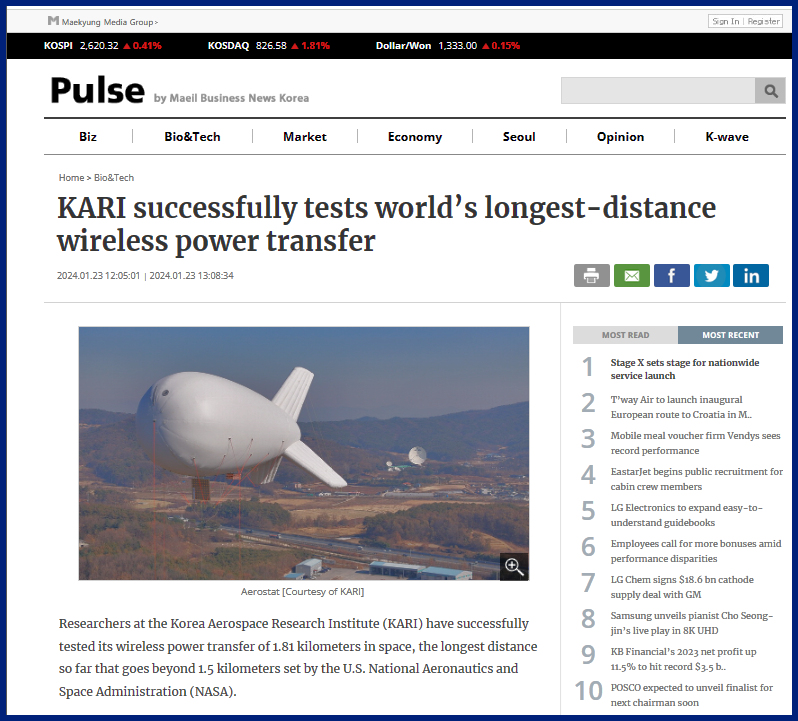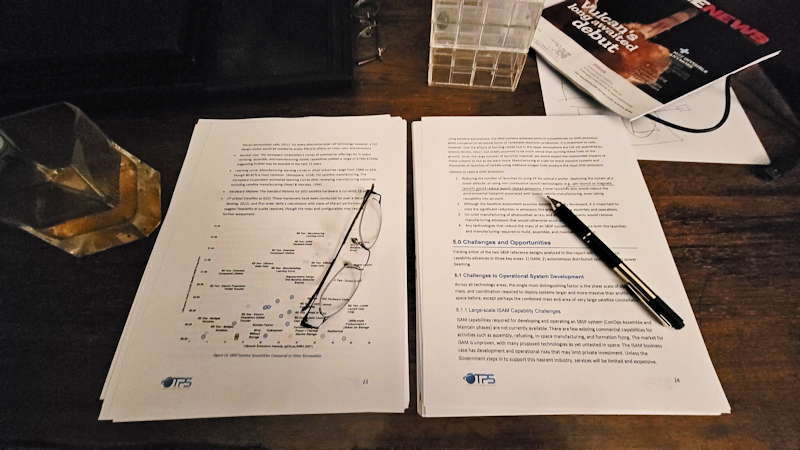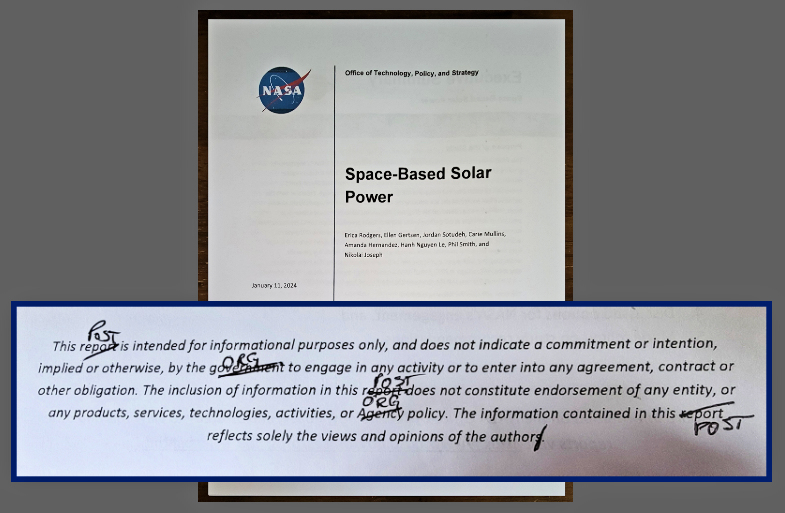January 2024 will go down as an important month in the ongoing development of Solar Power Satellite technologies.
On the non-USA development side, according to reports (https://pulsenews.co.kr/view.php?year=2024&no=57487 ) the Korea Aerospace Institute (KARI) performed a wireless power beaming experiment that “beat” the distance record held for 49 years by Dr. William Brown of Raytheon.

It should be pointed out that while that article does an SPS tie-in, the work was forged for other applications just as Bill Brown added SPS to military and other uses for the reasons for the Goldstone experiments, but still, that’s pretty darned big news. It is sad that it took so incredibly long to break the record and some of us who have been alive since ’75 may have had to check our math and come to grips with how many more white hairs we have at our temples than years in the span but, as we think SSI Senior Advisor Bill Brown would say: “FINALLY! Hardware instead of just talk!”
Because *Hardware*, proof by ‘bending tin’ and getting blisters from hot metal instead of just cherry-picking through conclusions based on previous opinions based on previous opinions based originally on hopes and desires (both for *and* against) is the only result that really matters.
“Bending Tin.” Or, as a person messaged me after SSI posted the above link on Facebook: “… for 60 years Boeing said all ideas of landing a rocket on its fins and using it again were silly childish ignorance and their view determined their government funding… until Elon just went and did it without them.”
Touche’ KARI and KERI. It is a sincere hope that this time countries will keep up their own independent funding for hardware tests instead of taking their lead solely from the fundings of the United States.
Which brings us to The Report.
Coming on the heels of that hardware announcement was one that has drowned it out, NASA’s first official analysis of of Solar Power Satellite potentials in decades. “Space-Based Solar Power” written by Erica Rodgers, Ellen Gertsen, Jordan Sotudeh, Carie Mullins, Amanda Hernandez, Hanh Nguyen Le, Phil Smith, and Nikolai Joseph and released by the Office of Technology, Policy and Strategy.
This is a report years in the teasing and in that time the hopes for it grew in the minds of SPS proponents like the hopes of nerds for a Dune movie to finally capture Frank Herbert correctly.
And then it came out.
Between us, right after its public release, we were, like the Space Foundation and the National Space Society, poised to pounce… but the Space Studies Institute has been around with SPS for a very long time, we have seen the ebbs and flows of opinions, and the motivations and inescapable biases behind them repeatedly and so [as the not-always-humble fellow SSI Associate writing this post was advised] we took some time to read, re-read and mull.

If you have not read Report 20230018600 personally, for yourself, then we strongly recommend that you do. Read it. For yourself. Here is the link again: https://www.nasa.gov/wp-content/uploads/2024/01/otps-sbsp-report-final-tagged-approved-1-8-24-tagged-v2.pdf
We will note, just as a heads-up, the experiences we have heard from others have included not continuing past the very first page because of the line:
“While it is generally understood that SBSP is cost prohibitive and technically infeasible today, this study assesses operating SBSP system in 2050.”
Yes, to some it does read like an echo-chamber opener from a junior journalist who has set their opinion and then only looked for data points that would support their view. And yes, some folks who have been involved with the plans for Solar Power Satellites for a while saw that “… in 2050” and said ‘once again, the paper NASA falling back on another 20 year can-kicking’, but Keep Reading. We have observed that that single page 1 sentence alone has put off some others from going any further into this important 92 page report, but don’t let it stop YOU.
Also, know up front that any public interest in the potentials of a really major project that could have existential or – god forbid – economic benefits to regular rank and file individual citizens that is loud enough to force NASA to spin cycles where they are not all that interested IS going to have a significant amount of “LAUNCH COST” and “LAUNCH IMPACT” bullet points heaping up in the negatives. Don’t do the old joke of: “And whose fault is that, NASA?” It is what it is. Just accept it.
Correctly, so long as any project’s end artifacts require significant mass, launches will be a real negative… especially if, as has been the case for, well, for NASA Forever you refuse to consider that significant mass does *not have to* be launched from Earth. Even though it just doesn’t have to be. It doesn’t. If you have a Space perspective.
The studies and work done for effective ways to nearly eliminate the cost of heavy launches from Earth, eliminating not only the cost of the rocketry but all of the environmental costs of chemical launches (that this report harps on) is a very long-standing elephant in the SPS living room. And in this report, again, the official conclusions do not include Space-Based options… even WITH this report’s up-front messaging that the consideration of SPS is for “2050.”
Put that date, “2050”, together with the report’s overwhelming use of Starship launches for data – and notice with a quick CTL-F search of the pdf how many mentions there are of SLS. Some find that silence telling of NASA’s big picture abilities. As do some view the amount of information on how the Artemis program could be used as a Materials Benefit for SPS and other construction projects instead of just as a “mission” to be checked off. Eventually. Maybe. By 2050. Unless it slips.
Read the report. Take your time. Do it twice so that the emotions, pro or con, get their first shot and then push your logical brain to spot the little, special, things. Because they are there too.
Section 5.3 has some fast bullets that are good for NASA to mention (you will be excused to think that they are mentioned in an odd manner, perhaps a bit forgetful of past NASA and DOE research) such as 5.3.1 Active Debris Removal, and 5.3.2 Spectrum Allocation and 5.3.4 Security.
And, hopefully happily, there are a couple of things scattered in that show that there is some hope beyond the “While it is generally understood that SBSP is cost prohibitive and technically infeasible..” majority of statements. Let’s not let anyone get conspiratorial and start thinking that a proofreading censor just fell asleep and missed them, they are there.
Such as on page 29 where the amount of actual interest from NASA that can be shown by physical hardware development is stated plainly: “NASA’s efforts are currently focused on research rather than technology development” and the note of NIAC, which is a nice program but… you know.
For some American pride, in that same paragraph the report does say: “… the Air Force Research Laboratory (AFRL) is developing an in-space power beaming experiment”. It’s not NASA, but it’s American. Go Air Force! May you do more than the Navy (https://www.wired.com/2014/03/space-solar/ ).
Related to that point, page 31 mentions the actual work being done by other countries (listed on page 3: “the United Kingdom, the EU, Japan, China, South Korea, and Australia”) with the admission: “.. NASA-funded power beaming work today is limited to paper research”. And that is followed up with what we should assume makes it a good thing (?) with: “Continuing to invest in these capabilities, even while taking no new action, will make SBSP systems more technically feasible in the future.”
“… even while taking no new action…”
Because you are reading this and can’t hear my sighing or see my winking, I will answer the question: “Isn’t this nit picking?” Maybe it is. The Space Studies Institute has been fundamentally involved with getting SPS off the ground and benefiting Earth for a lot of years, so many of us can’t escape biases – we can only acknowledge our reasons for them (https://ssi.org/a-free-pdf-from-ssi ).
And we will mention that it is perhaps because of our bit of bias born from our history, that we spotted this interesting line on page 24:
“Reducing the number of launches by using EP for orbital transfer, deploying the system at a lower altitude, or using non-combustive launch technologies (e.g. spin launch or magnetic launch) would reduce launch related emissions. Fewer launches also would reduce the environmental footprint associated with launch vehicle manufacturing, even taking reusability into account.”
That bullet is raised as part of the deluge of environmental negatives of mass launches from Earth, “Options to reduce GHG emissions”, but it is there… “magnetic launch”.
Magnetic Launch.
Magnetic Launch.
And it is followed by:
“On-orbit manufacturing of photovoltaic arrays and other components would remove manufacturing emissions that would otherwise occur on Earth.”
And:
“Any technologies that reduce the mass of an SBSP system would reduce both the launches and manufacturing required to build, assemble, and maintain the system.”
It’s just a break in the clouds, a passing not-dwelled-on moment, but those lines are there.
Read the report. Read it twice.
There have been a number of reviews of Report 20230018600, and here are some of the biggies…
Jeff Foust in “The Space Review: Did a NASA study plug the plug on space solar power?”
https://www.thespacereview.com/article/4737/1
and Mr. Foust again, in Space News: “NASA report offers pessimistic take on space-based solar power”
https://spacenews.com/nasa-report-offers-pessimistic-take-on-space-based-solar-power/
David Steitz in Space News with “NASA study: clean, space-based solar power beaming is possible”
https://spacenews.com/nasa-study-clean-space-based-solar-power-beaming-possible/
Daniel Clery in AAAS Science: “Is NASA too down on space-based solar power?”
https://www.science.org/content/article/nasa-too-down-space-based-solar-power
And there are off-the-beaten path sources (not bad at all, just a bit less travelled by the general population) like
Tim Fernholz in Payload Space with: “NASA Nixes Solar Power From Space (At Least For Now)”
https://payloadspace.com/nasa-nixes-solar-power-from-space-at-least-for-now/
… but please do it for yourself. Your tax dollars paid for it. You paid for it. We will all pay for the ramifications of it being read by others. And it is right here for you to read and to know:
Hey, I was just looking for something else and this jumped up on my drive. It wasn’t a planned part of the above and we’re not saying there’s any relationship, it’s just a little bit o’ internal SSI history that apparently wanted to be heard.
A few words from our founder.
For more, much more, on Solar Power Satellites, see this special section on ssi.org.


